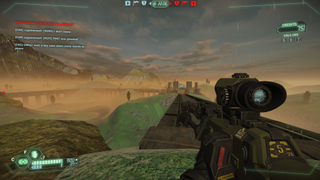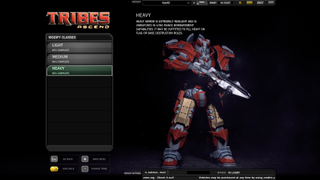The many sins (and possible redemption) of Tribes: Ascend

Things looked so good for Tribes Ascend when it was released in early 2012. “Wonderful, breath-clutching games of chicken happen along the z-axis in Tribes: Ascend,” wrote Evan Lahti in our review. We loved it. We played it. But it needed love from its developer, too—bug fixes, new maps, tweaks to make it more fun, major changes to the F2P economy. Instead of getting better with patches and updates, Tribes: Ascend got worse. A year later, it was all but abandoned by Hi-Rez Studios, which moved on to its now-successful MOBA Smite. All but a few players were gone, too, and the ones who stayed were angry and bitter.

Before Tribes Ascend, Hi-Rez prototyped a Tribes MMO called Tribes Universe. They already had the resources for an MMO thanks to Global Agenda. But it wasn't a good fit (thanks to the high-speed skiing Tribes is known for).
Tribes Ascend started life as an Xbox Live title. When Quake Live flopped, Microsoft cautioned against an Xbox release. Hi-Rez shifted to PC and F2P partway through development. That's when they split light/medium/heavy into nine classes.
Now, out of the blue—the apt name for Tribes: Ascend’s first patch since 2013—Hi-Rez has returned to the game to fix its many, many missteps. It’s a small team, and they don’t expect to make money off the game. But they may be able to make things right.
“We made a lot of mistakes in a lot of different places,” creative director Sean McBride told me on a recent trip to Hi-Rez. “Pricing definitely was off. Way too expensive in the beginning. Both for XP, our earned currency in the game, and gold.” And money was just one of Tribes: Ascend’s problems, which McBride talked candidly about. It was a refreshing conversation—you rarely hear developers so openly talk about everything they did wrong.
“It’s death by a thousand cuts, right?” McBride said. In the early days, Hi-Rez patched Tribes, but the patches were bad. Weapon releases bloated the game. So he’s ditching those. Ascend’s perk system included some overpowered abilities and some worthless ones. So they’re getting rid of it. Everything was too expensive, so they’re refunding every player the gold they spent to re-buy weapons and equipment as they please.
“We’re pulling back on a lot of the patches we did post-launch,” he said. “They had tons of weapons in them. At the time our numbers always bumped up when we had patches with weapons on them. People come back for new content. But it wasn’t quality content at all. We were just scrambling to get content in the game, and we had this tiny team. So we created variants of the weapons, basically. And they were useful variants, it wasn’t like they were just junk. But it bloated the game.”
"It's death by a thousand cuts, right?"
One example: The Jackal, a triple-round burst sticky grenade launcher. Unlike the rest of Tribes: Ascend’s weapons, you could detonate it in the air whenever you wanted. That made it a lot of fun—and completely broken in the hands of better players. “It wasn’t designed to be pay to win, but it ended up being pay to win. Because people are better at your game than you are.”
Surprisingly, even at the height of Tribes: Ascend’s development, it was being handled by a very small team. “I think at our biggest we were like 15, but it didn’t stay at 15 for very long,” said McBride. “It was a passion project from the beginning. I think there were many weeks where I pulled over 100 hours just to try to get Tribes done. That wasn’t just me. That was people I was working with as well.”
PC Gamer Newsletter
Sign up to get the best content of the week, and great gaming deals, as picked by the editors.
Hi-Rez was a much greener studio at the time, and in a way the positive reviews and buzz for Tribes proved to be its undoing. “We didn’t really listen to the community,” McBride said. “Once the high scores rolled in...PC Gamer gave it Editor’s Choice, and we got a couple 10s and a bunch of nines and a few eights. We did pretty well on the scores. I think at the time we were very resistant to changing the game. We were like, ‘people like it, it scored really well.’ It wasn’t until the numbers started to fall that we really would consider even changing it. There was a big resistance to listening to feedback from the community, which wasn’t the right call.”
Another tactical error: releasing Tribes a mere month before Diablo III. McBride remembers being worried that the older PC playerbase, which had played the original Diablo and Tribes in the late 90s, would leave Ascend for Diablo.
“As soon as Diablo came out our numbers tanked and we never recovered from those numbers,” he said. “That definitely wasn’t the reason we didn’t take off. We were already starting to dip, but once you lose the players it’s hard to get them back.”
As Tribes floundered, Hi-Rez moved what remained of its small team to work on Smite. Two years later, Hi-Rez has ballooned from a studio of around 50 to more than 200 on the back of Smite. That’s given them the resources to dedicate a small three-person team to Tribes, with programming and art resources occasionally borrowed from other teams, even if the game can’t turn a profit. When McBride took charge of Tribes a few months ago, he dug through forums, reddit posts, and old Youtube videos to assemble a massive list of changes the game needed. There was, as he expected, a lot of hate.

“But I listened to what the competitive community wanted, and all of it made sense,” he said. “It was a lot of the things we were already saying internally. Which is usually the case. We see the game first and look at it and are like, these things are screwed up.”
Last week, after a few months of experimenting with the community on a public test server, Hi-Rez released the first new patch in two years, and a lot has been changed. The nine classes have been condensed into light, medium and heavy. The loadout system has been revamped and everything has been rebalanced. Perks were removed and distributed among the armor classes. The hitbox toggling cheat was finally addressed. There are three new maps and fewer useless weapons.
The “out of the blue” patch isn’t a funeral dirge for Tribes, either. McBride said another patch will follow. His hope is to see a bump in player numbers, but he doesn’t know if they’ll stick around. “That’s partly why we’re experimenting with game modes right now,” he said. “If we bring back the middle core player, the people who really loved the game but didn’t stick around for very long, if they come back around and there’s nothing really that new, like a new game mode that is a very different experience, they’re probably going to drop out again after about a month.”

But this patch, at least, is not concerned with players who might come back and dabble. “It’s for the hardcore guys that stuck around,” he said. “There was some concern that the hardcore guys were going to want things that made the game a lot harder. A bad experience for new players. I found that to not be the case at all. They actually wanted things that made it a little easier. They weren’t asking directly for things to make it easier, but what they were asking for made it a little easier.”
Since its patch, Tribes: Ascend hasn’t seen a big enough uptick in players to settle into Steam’s top 100 most-played games, but it has grown (and not all of its players launch the game through Steam). “I myself, am loving the abundance of players...the return of old players, and of course, the acquisition of new ones,” wrote one player on the Tribes subreddit. “There is no denying that T:A has seen a dramatic surge in popularity since the launch of Out Of the Blue. The new wave of players has undoubtedly brought both optimism and hope to a subreddit that was previously full of wry humor, bitter sarcasm, and dwindling creativity. While I do not expect this second breath to last forever, I do plan on riding this wave as far as it can take us,” wrote another.

The community seems energized—and hungry for more updates, which Hi-Rez says are on the way. For now, people are finally playing Tribes again.

Wes has been covering games and hardware for more than 10 years, first at tech sites like The Wirecutter and Tested before joining the PC Gamer team in 2014. Wes plays a little bit of everything, but he'll always jump at the chance to cover emulation and Japanese games.
When he's not obsessively optimizing and re-optimizing a tangle of conveyor belts in Satisfactory (it's really becoming a problem), he's probably playing a 20-year-old Final Fantasy or some opaque ASCII roguelike. With a focus on writing and editing features, he seeks out personal stories and in-depth histories from the corners of PC gaming and its niche communities. 50% pizza by volume (deep dish, to be specific).
